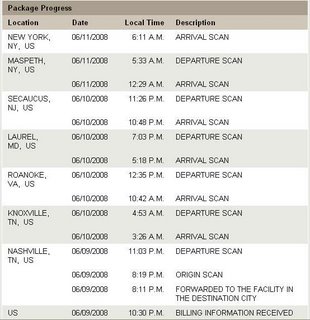October, Again
Back in January, I theorized that a significant danger to Senator Barack Obama’s election hopes would be an “October surprise”: a terrorist attack on the United States that would serve up an unhealthy dose of fear, and scare Americans into voting for the Republican candidate. Several weeks after that, it all popped up again, with subtle leaks of a new Al Qaeda plan. At the time, I wrote: “A slow news trickle about a renewed capability to attack the United States on the part of our Public Enemy #1 – now, as the presidential race takes on a different shape with a presumptive nominee for the Republicans – fits this pattern. It serves a valuable purpose for the tail end of the Bush administration, shifting focus away from the reeling economy and back towards the fear that provokes bad decision-making on the part of both voters and our Congress.”
And five months later, the issue is back – and this time, it is not just me theorizing about it.
In an upcoming issue of Fortune magazine due out July 7th, but available online earlier), Charles Black, an advisor to Senator and Republican presidential candidate John McCain acknowledged that a terrorist attack on the U.S. would help his candidate – as was seemingly shown by the murder of Benazir Bhutto in Pakistan. David Whitford, the article’s author, wrote: “‘The assassination of Benazir Bhutto in December was an “unfortunate event,”’ says Black. ‘But his knowledge and ability to talk about it reemphasized that this is the guy who's ready to be Commander-in-Chief. And it helped us.’ As would, Black concedes with startling candor after we raise the issue, another terrorist attack on U.S. soil. ‘Certainly it would be a big advantage to him,’ says Black.”
Does anyone still doubt the likely GOP strategy for trying to win the November election?
Needless to say, the McCain campaign has been trying to backpedal. A bit. Sort of. On Tuesday, the Associated Press reported that Senator McCain “disavowed” Charlie Black’s comments, although if you read McCain’s quote as reported, it is not so much a disavowal of Black’s point, rather just an assertion that McCain doesn’t like terrorism: “I cannot imagine why he would say it. It's not true. I've worked tirelessly since 9/11 to prevent another attack on the United States of America. My record is very clear.” Working “tirelessly” to fight terrorism and believing that an attack would help your odds are two different things, Senator McCain.
(As if understanding this point intuitively, but unable to spell it out directly, the AP article noted: “The GOP also questioned the Democrats' record on national security in 2002, with White House political adviser Karl Rove saying Republicans should not shy away from citing terrorism concerns as a reason to vote for their party.”)
Anyway, having Black say it is merely part of the strategy, too: fear needs little proof to be effective. The Obama campaign (rightly) went to town on this. The Washington Post’s Howard Kurtz picked up the issue. In today’s New York Times, Frank Rich nailed it. Even the conservative Wall Street Journal had a little trouble swallowing this one, though it did quote an expert who agreed that an attack would help McCain. (Favorites? The Tehran Times, calling it “Black’s faux pas” and helpfully defining “faux pas,” and Al Jazeera, which wrote “US election diary: The mask slips.”) Many more news outlets wrote, too, if you want more reading.
We have not heard the last of this issue. Best case scenario: it remains an election issue in words only. The worst case scenario? I would prefer not to think about it, and it remains too easy to imagine.




